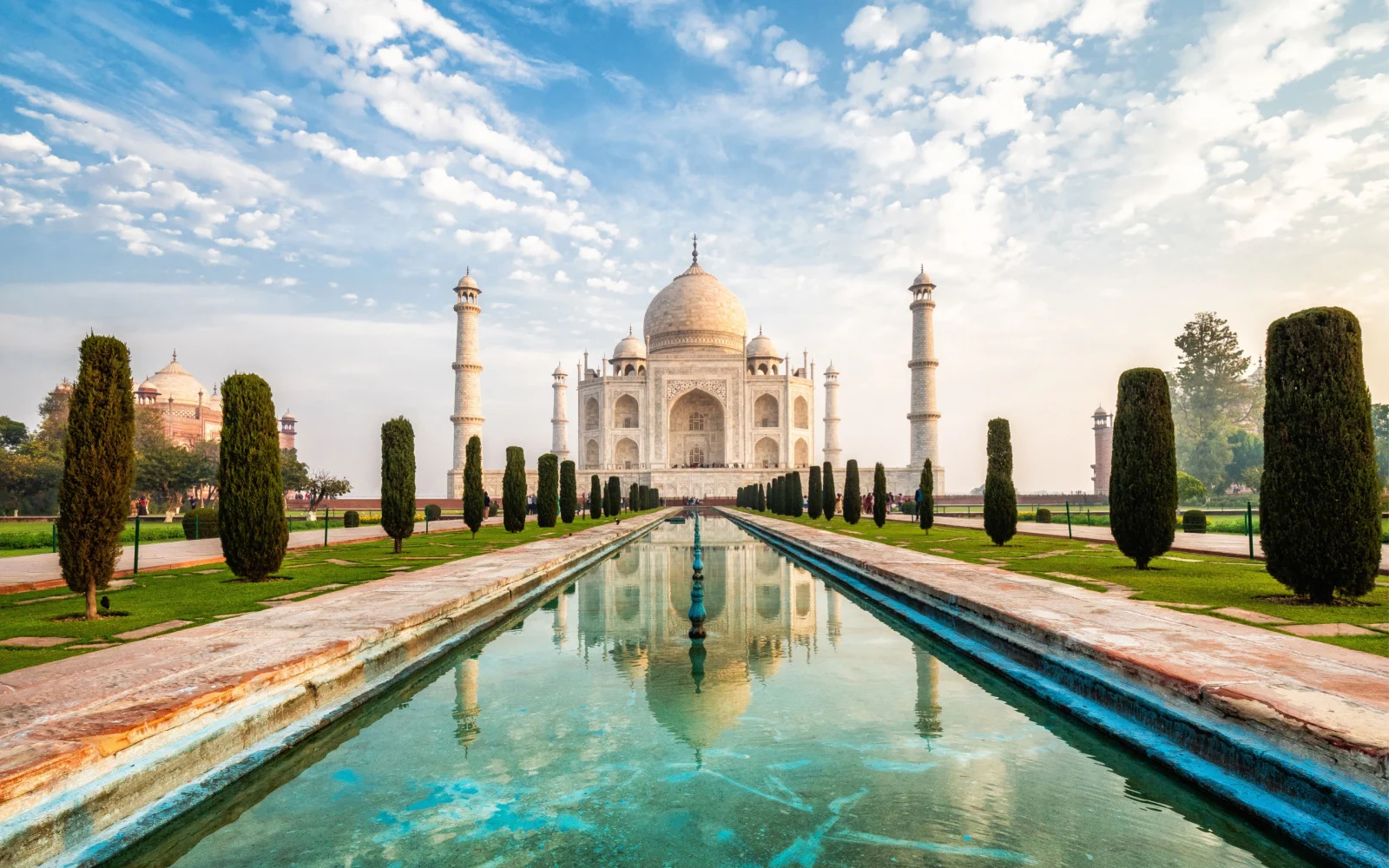As of 2021, India ranked 18th in the world on the list of most popular tour destinations, and we have no trouble seeing why. It’s one of the most beautiful places on Earth, covering an entire subcontinent with jungles, deserts, mountains, coastlines, and cities.
From the Indus River Valley civilization to the skyscrapers of modern-day New Delhi, Mumbai, and Kolkata, it has been a center of human ingenuity, spirituality, and learning for more than 4,000 years.
Today, people flock from all over the world for an experience like no other. If you’d like to join them, here’s everything you need to know about how to save money doing it.
Average Trip to India Cost in 2024
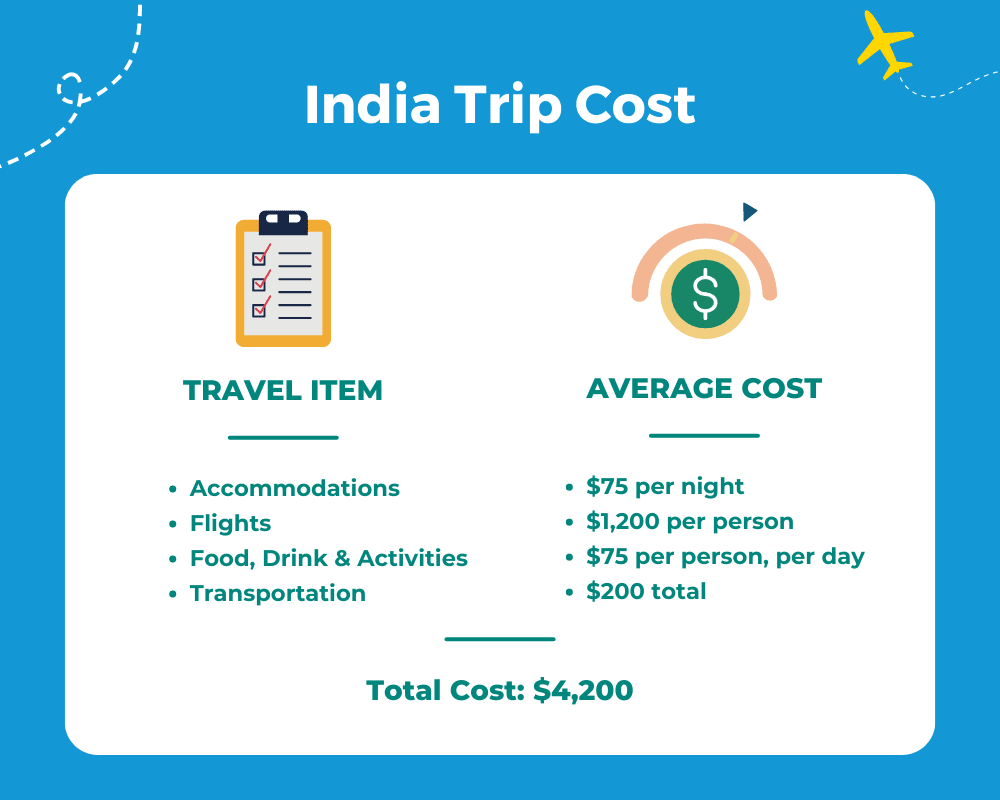
An average one-week trip to India for two people will cost around $4,200:
- Average Accommodation Cost: $75 per night
- Average Flight Cost: $1,200
- Food, Drink & Activities: $75 per person, per day
- Transportation: $200 total
- Total Cost: $4,200
If you’re a budget traveler, you won’t do better than India. The country is famous for its affordability without sacrificing comfort or convenience.
With good infrastructure, delicious food, and a whole subcontinent of beauty and culture to explore, you’ll get your money’s worth here. One of the reasons India is such a great place to travel is that not only is it cheap, you get serious value for every dollar you spend.
If you spend $10 on a guesthouse, you can find one free of bedbugs or disease.
If you spend $100 on a resort, you know that you’re getting the full resort experience: a pool, beautiful views, lovely food on site, and a welcoming staff. That doesn’t mean there aren’t plenty of ways to save money, though.
Below, we’ll discuss some of the best ways to reduce costs on accommodations, flights, activities, consumables, and transportation. We’ll also cover some quick tips and FAQs to give you all the information you need for planning a trip to India.
India Trip Cost: Average by Item
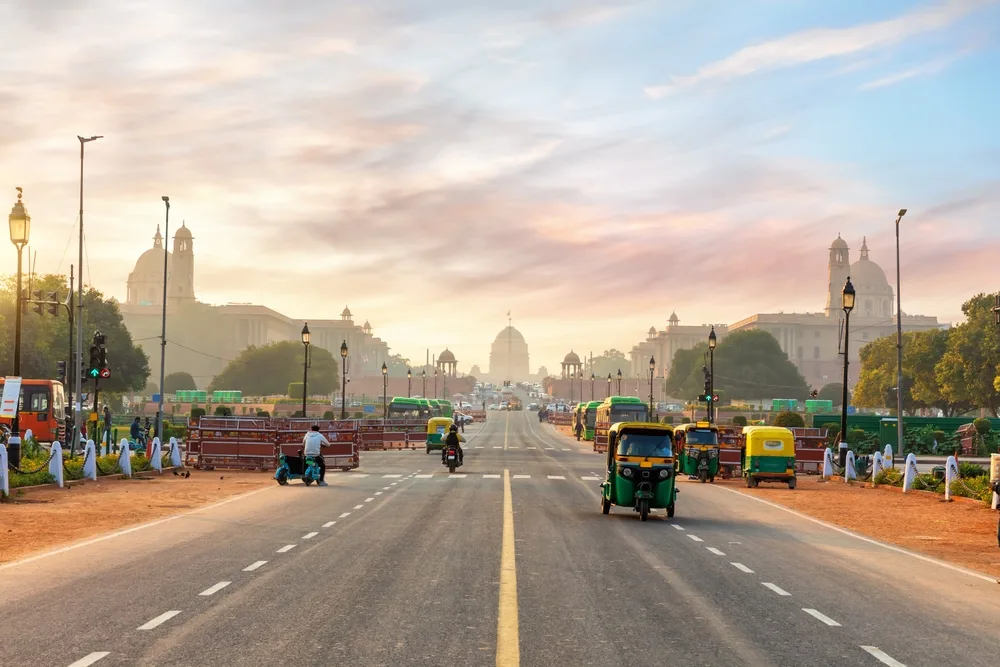
AlexAnton/Shutterstock
India is very affordable, but naturally all cost estimates are just that: estimates. Depending on where exactly you go, how many people are in your group, what level of luxury you desire, and the time of year, you will see different costs than another traveler.
The below, however, will help provide a starting point so you can begin to save for your trip.
Accommodation Costs
Staying in India is very, very, very (times a million) affordable. You can get a bunk in a nice guesthouse for only $5, while a room at a hotel is about $25 to $50.
If you want to stay in a nicer hotel with a bit of luxury, you’ll pay about $75. Since everything else in India is so affordable, it’s worth shelling out for a nice, clean, and safe place to stay, so we recommend the latter budget.
A helpful way to save money in India is to travel during the off-season. The high season in India is the coolest and most beautiful, from October through March, but this is also the most expensive.
If you’re willing to go during monsoon season in summer, however, you can see savings of up to 50 percent on hotels and other costs. As an added bonus, monsoons are beautiful in the countryside.
Flight Costs
The average cost of a round-trip flight from New York to the territory of Delhi is around $900 during the low season, but is likely higher in the winter months.
From Los Angeles to Delhi, it’s about the same. Plan on a long travel day, though, usually between 15 and 24 hours.
Assuming you might have to travel from a smaller city to a hub, you should tack on a few hundred dollars and a few more to account for seasonal variation. Let’s call it an even $1,200. One of the smartest things you can do when traveling to India is only fly into the big cities.
If you fly directly into a smaller destination from out of the country, you will pay a massive surcharge. New York to Kerala (a state in India), for instance, is about $1,800.
From Delhi to Kerala, on the other hand, is $100 or so. As you can see, that’s a huge difference. Flying from the US to Delhi, then buying a domestic ticket once in India, will cost you about $1,300.
On the other hand, planning everything from outside India’s borders will cost an additional $500 per person. Can we just say, yikes? The choice is clear.
Food, Drink & Activity Costs
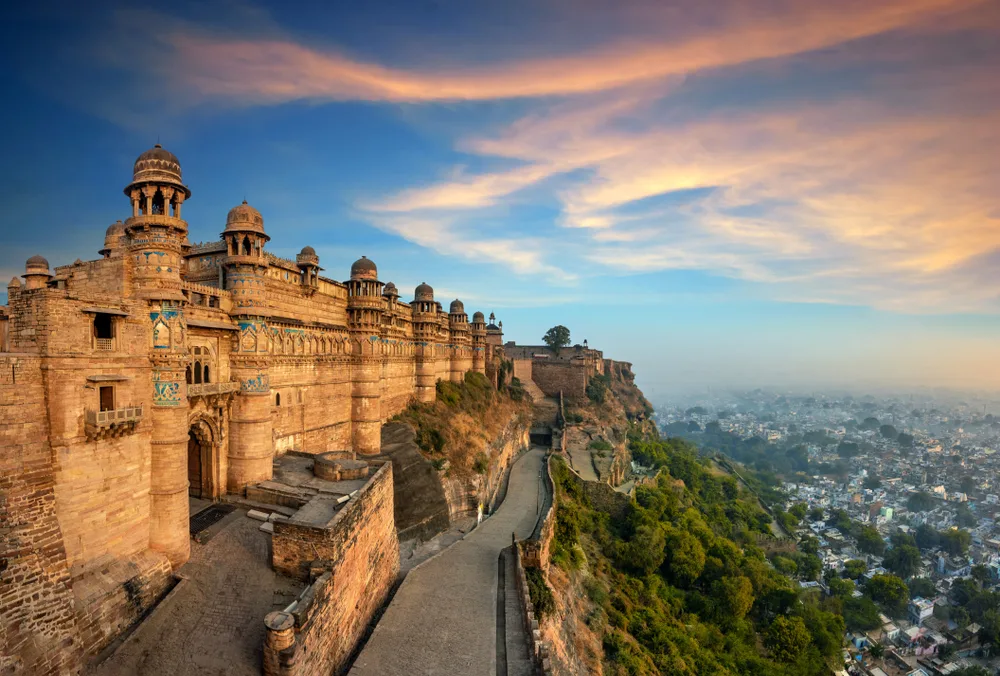
ImagesofIndia/Shutterstock
Food is extremely affordable in India, and so is drink. Fine dining will cost you around $25 per person, while a cheap but delicious local meal is about $5. Budgeting for a drink or two, you can live well on $50 per person, per day.
That doesn’t include activities, though, of which there are many in India. However, these are downright freakishly affordable as well. It costs about $3 to see the Taj Mahal, including the mausoleum.
A rafting trip or jungle tour is only about $20 per person. Rounding up, India is a great place to vacation for $75 a day or less. And we encourage you to whip out those haggling skills.
Not everyone feels comfortable bargaining over a taxi cab fare or a necklace in the marketplace, but if you do, you’ll get a much better deal.
The stated price of something is often intentionally overpriced because the locals expect you to try and talk them down. Of course, they’re always happy to have you pay the full amount!
On a final note, you can save money on souvenirs by staying out of shops and buying your knickknacks and gimcracks at markets and street stalls. The same goes for art and clothing, all of which are cheaper at the hands of small vendors and artisans rather than malls or chains.
Transportation Costs
Overall, transportation in much of India is cheap and efficient. You can get around town and country by bus, train, tuk-tuk (small carriages drawn by motorcycle), or taxi on just a few dollars a day.
However, there are some things of which you should be aware. For one, public transportation is a bit hazardous in India. It’s fine during the day, but even then, solo women may feel harassed.
It’s better to travel in a group if you’re female. Don’t travel alone at night, and avoid tuk-tuks and cabs after the sun goes down if you can. If not, vet cabs and decide on the transportation fee ahead of time.
Note that taxi drivers in India do not expect a tip, so you can save those rupees for something else.
You can get between big cities by train for almost nothing. Mumbai to New Delhi, for example, takes 18 hours but is only $7. You won’t get a bed, but you will certainly save money!
Overall, plan to spend about $200 on transportation all told. Though you’ll likely get away with less, it’s best to be prepared in case there’s an emergency or you need to hire a private car to meet a deadline.
Things to Consider
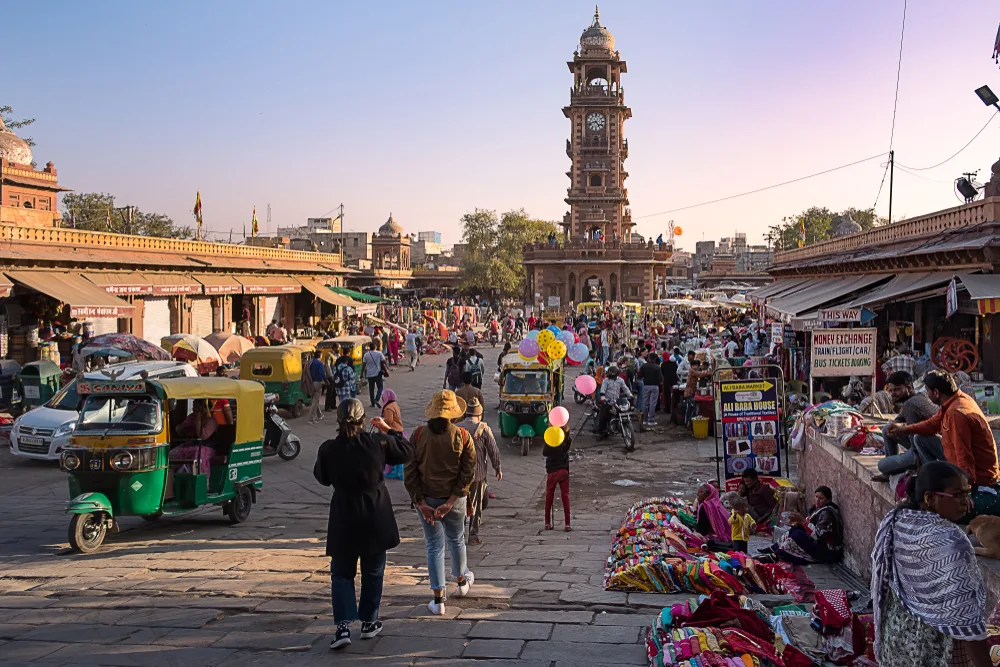
Thanida Siritan/Shutterstock
Now that we’ve discussed basics, here are a few more things to keep in mind:
- Safety in the cities is a major concern. You can increase your chances of staying safe by avoiding travel at night. If you must, take a licensed cab and travel with someone else. Avoid large gatherings, especially demonstrations and protests.
- Make sure to bring cash or exchange your dollars at the airport, before you step foot into the country proper. You cannot use dollars in India except at moneychangers or authorized hotels.
- India is big, and you won’t be able to see nearly all of it in a week. If you have two weeks to dedicate to the experience, definitely do it! If not, plan carefully to focus on the places you really want to see. Ideally you can limit your travel time between these places by staying in one quadrant of the country or by flying longer distances, which is pretty affordable.
- Buying plane and train tickets within the country is much cheaper than from the US. If you can stand the uncertainty until you get there and talk to a local travel agent, you’ll get steep discounts – sometimes half off or more!
- Select your hotel based on people’s reviews. Many travel companies have kickback deals from hotels and other places to stay, so star ratings aren’t enough information to get an accurate idea of a place. Instead, read up on the options from the horse’s mouth. And by “horse’s mouth,” we mean “traveler’s mouth,” of course!
Frequently Asked Questions
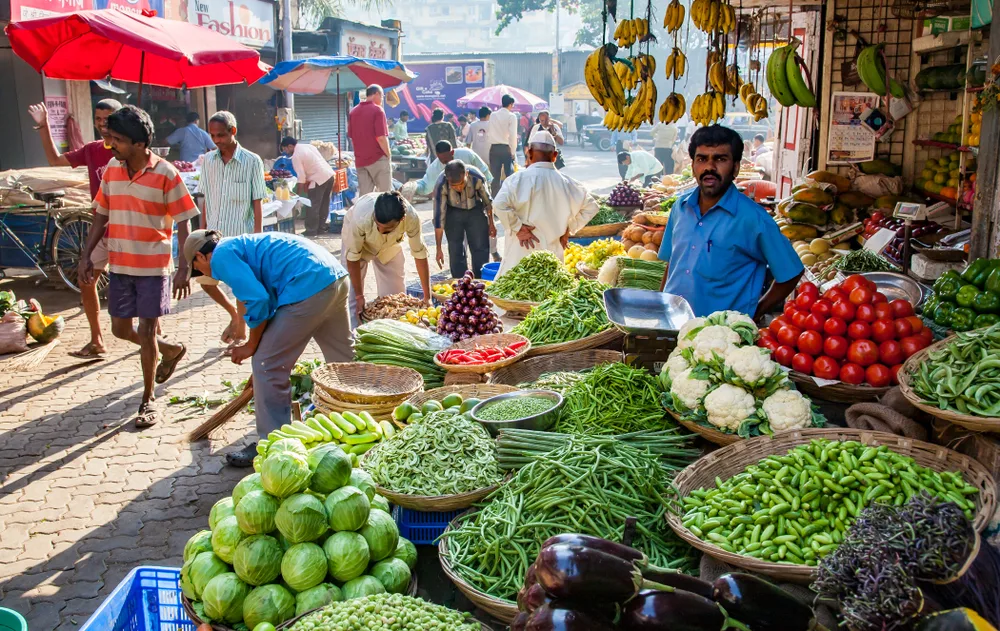
Mumbai, India – 2/2/2011: An Indian man is selling fruit and vegetables at a street market in Mumbai, India/Bob Pool/Shutterstock
Is it safe in India?
It is relatively safe in India if you steer clear of large crowds, stay inside at night, and stick to authorized taxi cabs when traveling around. However, you should be aware that, according to the US Department of State, “Indian authorities report rape is one of the fastest growing crimes in India.
Violent crime, such as sexual assault, has occurred at tourist sites and in other locations. Terrorists may attack with little or no warning, targeting tourist locations, transportation hubs, markets/shopping malls, and government facilities.”
In some places in India, you can’t expect help quickly: “The U.S. government has limited ability to provide emergency services to U.S. citizens in rural areas from eastern Maharashtra and northern Telangana through western West Bengal as U.S. government employees must obtain special authorization to travel to these areas.”
It’s better to be safe than sorry, so if you’re not sure if a place or activity is safe, steer clear.
Do I need to get vaccinated?
There are a number of vaccines that will increase your safety when traveling in India. The CDC recommends chickenpox, diphtheria-tetanus-pertussis, flu, MMR, polio, and shingles shots.
When is the best time to visit India?
The coolest time of year is from October through March, which is also the most expensive time and when there will be the most competition from tourists. The low season – from June through September – is the least expensive, when costs can drop by a full half.
Is India expensive?
India is quite affordable, but if you’re not careful, you can end up paying more than you need to. Remember to haggle at small shops and markets as well as on the street, where you’ll almost certainly get a better deal. You can often get better prices on taxis as well.
Can I use dollars in India?
No. It is illegal for street vendors, shops, and other establishments to accept US dollars. You can only use rupees, so you’ll need to go to a moneychanger or exchange your dollars at a hotel or airport. Many places don’t accept credit cards, such as street vendors, so always have rupees on hand.
What clothes should I bring?
It’s usually pretty warm in India. For instance, in the Northwest in winter, it hovers between 50 and 60 degrees Fahrenheit, warming up to 70 or 80 degrees in the Southern parts of the country even during the coldest times of year.
Most places to which tourists will travel require long pants and shirts in the winter, or shorts and tanks in the summer. However, beware that not all of India is super warm. For instance, explains the Times of India, “Dras is India’s coldest place, and second to the coldest inhabited region on the Earth.
During winters, the average temperature can go below -40 degree Celsius. Famed as the Gateway to Ladakh, Dras features rugged terrains, majestic mountains, and freezing cold temperatures too.”
All of which is to say, beware of researching too shallowly, because you might arrive in very cold climes unprepared!
So, What Is the Average Cost for an India Trip?
| 🛎️ Average Accommodation Cost | $75 per night |
| ✈️ Average Flight Cost | $1,200 per person |
| 🍽️ Food, Drink & Activities | $75 per person, per day |
| 🚕 Transportation | $200 total |
| 💲 Total Cost | $4,200 |
The average cost of a one-week trip to India is around $4,200 for two people. You can lengthen the trip and it will become even more cost-effective, because the majority of the expense comes from getting to India in the first place.
However long you stay, you’re certain to love this lovely, cultured, historic corner of Planet Earth as much as we do!



